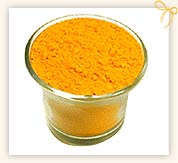 Hinduism is a religion of ceremonies and rituals. The
elaborate ceremonies consist of many religious products. Holy powders
and pastes form an integral part of any Hindu pooja. The most commonly
used powders and pastes are :
Hinduism is a religion of ceremonies and rituals. The
elaborate ceremonies consist of many religious products. Holy powders
and pastes form an integral part of any Hindu pooja. The most commonly
used powders and pastes are :
 |
||||||||||||||
|
|
||||||||||||||
|
HinduOfUniverse Holy Powders & Pastes Hinduism is a religion of ceremonies and rituals. The
elaborate ceremonies consist of many religious products. Holy powders
and pastes form an integral part of any Hindu pooja. The most commonly
used powders and pastes are :
Hinduism is a religion of ceremonies and rituals. The
elaborate ceremonies consist of many religious products. Holy powders
and pastes form an integral part of any Hindu pooja. The most commonly
used powders and pastes are :Kumkum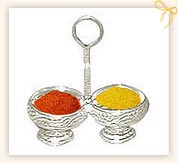 The traditional Kumkum or Kungumam(in Tamil Nadu) is
made from dried turmeric. The turmeric is dried and powdered with a
lime/lemon giving the rich red colored Kumkum or Roli. Kumkum is used
as a "Tilak" for Hindu Gods and also by Hindu males.
The traditional Kumkum or Kungumam(in Tamil Nadu) is
made from dried turmeric. The turmeric is dried and powdered with a
lime/lemon giving the rich red colored Kumkum or Roli. Kumkum is used
as a "Tilak" for Hindu Gods and also by Hindu males.Kumkum, which is made from the turmeric powder is an auspicious symbol. Kumkum is applied to the forehead of a visiting girl or married woman as a sign of blessing and respect. However, it is not offered to widows. Men wear the mystic central kumkum dot as a mark of spiritual intelligence and also during religious ceremonies. Historical aspect of Kumkum In the ancient Puranas like "Lalitha Sahasranamam" and "Soundarya Lahari", the practice of using kumkum on the forehead has been mentioned. Legends talk about Radha turning her kumkum into a flame like design. Practices Associated with Kumkum According to ancient beliefs, the sixth chakra called "Agna" is present in the area between the eyebrows. This chakra is said to be the seat of concealed wisdom, command and concentration. During meditation, the latent energy ("Kundalini") rises from the base of the spine towards the head. This "Agna Chakra" is the probable outlet for this strong energy. The red kumkum between the eyebrows is said to retain energy in the human body and control the various levels of concentration. Kumkum represents intellect and is a symbol of auspiciousness and happiness in the family. It also denotes "Soubhagya" (good fortune) when used by Indian women denoting that their husbands are alive. A widow never wears kumkum. Kumkum is also not worn during mourning. Pooja Bells (Ghanta/Ghanti) The Bell, known in Sanskrit as the Ghanta/Ghanti
is used in all poojas for invoking the Gods. The ringing of the bell
produces what is regarded as an auspicious sound. It produces the
sound Om, the universal name of the Lord. There should be
auspiciousness within and without, to gain the vision of the Lord who
is all-auspiciousness.
The Bell, known in Sanskrit as the Ghanta/Ghanti
is used in all poojas for invoking the Gods. The ringing of the bell
produces what is regarded as an auspicious sound. It produces the
sound Om, the universal name of the Lord. There should be
auspiciousness within and without, to gain the vision of the Lord who
is all-auspiciousness.Another significance of ringing the bell is that they help drown any inauspicious or irrelevant noises and comments that might disturb or distract the worshippers in their devotional ardor (dedication), concentration and inner peace. In mandirs (Hindu temples) aarti is performed daily by pujaris (priests). There is usually a 'mangala-arati' first thing in the morning, another later in the morning, one at lunchtime, and the final aarti of the day at sundown. Devotees sing various types of kirtana and bhajans during the aarti ceremony. The pujari performing aarti first purifies his hands with sacred water from the acamana cup. He then sprinkles three spoonfuls of water over a conch, and blows it three times. He then lights an odd number of incense sticks (usually three) from a ghee lamp standing beside the altar. While ringing a small bell, he waves it seven times around the deities, and then he waves it once to the assembled devotees. The fine combination of pure brass and bronze produces a harmonious and rich tonal sound when rung by hand while singing the Aarti or even chanting traditional Mantras for worship. Prayers or Pooja of any kind on any occasion are incomplete without the joyous sounds and chanting of Bell. We chant this mantra when we ring the bells : Agamaarthamtu devaanaam Gamanaarthamtu rakshasaam Kurve ghantaaravam tatra Devataahvaahna lakshanam I ring this bell indicating the invocation of divinity, So that virtuous and noble forces enter (my home and heart); And the demonic and evil forces from within and without, depart. Betel Leaf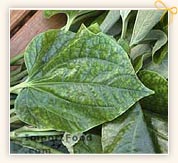 Botanical Name: Piper betel
Linn.
Botanical Name: Piper betel
Linn.Family: Peperaceae, The Betel Leaf Family Indian Name: Paan The betel leaf enjoys the pride of place among all the accessories of a traditional Hindu pooja thali. The betel leaf denotes freshness and prosperity. Betel leaves or the tambool, which comprises betel leaf, betel nut and lime, marks the beginnings of all auspicious events. Betel leaf is an evergreen perennial, with glossy heart-shaped leaves and white catkin inflorescence, and grows to a height of about 1 metre. The Betel plant originated in Malaysia and now grows in India, Indonesia and Sri Lanka. The best Betel leaf is the "Magahi" variety (from the Magadha region) grown near Patna in Bihar, India. Since antiquity, Betel leaf is much more popular in India than in any other country of the world. This would be evident from the numerous citations laid down in the ancient Indian scriptures. In these citations, significance of the leaves has been explained in relation to every sphere of human life including social, cultural, religious and even day-to-day life, which is very much relevant even today. For example, a well-prepared betel quid is still regarded as an excellent mouth freshener and mild vitalizer, routinely served on the social, cultural and religious occasions like marriage, religious festivals, etc. Medicinal benefits Betel leaves are stimulant, digestive, carminative, anti flatulent, anti inflammatory, invigorating, anti phlegmatic, pain reliever. In Ayurvedic medicine, they are used as an aphrodisiac. In Malaysia, they are used to treat headaches, arthritis and joint pain. In Thailand and China, they are used to relieve toothache. In Indonesia, they are drunk as an infusion and used as an antibiotic. They are also used in an infusion to cure indigestion, as a topical cure for constipation, as a decongestant and as an aid to lactation. In India, they use betel to cast out (cure) worms. Betel Nut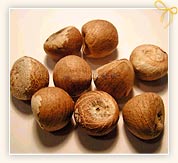 Botanical Name: Areca Catechu
Linn.
Botanical Name: Areca Catechu
Linn.Family: Arecaceae/Palmaceae, The Palm Family Indian Name: Supari The betel nut is an integral part of the daily or ritualistic Pooja. It is also popularly used in the age old-custom of Indian eating. The supari is symbolic of the nut of the ego that must be offered on the altar of God. It represents the hard, coarse qualities that must be surrendered to God, leaving only the soft, pure qualities. Mostly symbolic the Supari is many a times traditionally represented as the Nine planets (in the Navgrah Pooja) and takes the form of Deities like Brahma, Surya and others during different Poojas. The betel nut can also represent a human being. In Maharashtra, the wife's presence is must at important religious rituals. But if she is away or dead, a betel nut wrapped in a cloth can represent her. In Bengal, betel nut is believed to carry magical properties. it is placed under the pillow at night so that the sleeping person can see his future in dreams. Betel nuts are believed to increase prosperity and they are tied to the pandal, the grinder, the pounding stone, large utensils and the bridegroom's clothes. In North-West India, milk and cooked rice is offered to the village deity when betel nut trees are planted. This is called Deonar pooja. In Vikrampur, Goddess Bhagawati is worshipped as a mark of respect for the betel nut. Medicinal benefits Betel nut, also known as Pinang or Areca nut, is the seed of the Betel Palm (Areca catechu). Betel nuts are often chewed for their helpful effects, which are caused by the relatively high levels of alkaloids in the seed. Chewing betel nuts is an important and popular cultural activity in many Asian countries including India. Powder of betel nut is used as a constituent in some tooth powders. Other medicinal uses include the removal of tapeworms and other intestinal parasites by swallowing a few teaspoons of powdered betel nut, or by taking tablets containing the extracted alkaloids. Coconut Botanical Name: Cocos nucifera
Linn.
Botanical Name: Cocos nucifera
Linn.Family: Arecaceae/Palmaceae, The Palm Family In India one of the most common offerings in a pooja thali is a coconut. It is also offered on occasions like weddings, festivals, before using a new vehicle, bridge, house etc. The breaking of coconut before God coaxes us to break the hard nut of our ego before God. 'Nariyal' or 'Kopra' is a symbol of good luck and prosperity. Every auspicious work begins with the breaking of the coconut and the giving of 'Nariyal' is a traditional ritual. Types of Coconuts
Coconut is offered in the sacrificial fire whilst performing
homa. The coconut is broken and placed before the god. It is later
distributed as prasada. It is offered to please the god or to
fulfill our desires. There was a time when animal sacrifice (bali)
was practiced. Slowly this practice faded and the coconut was offered
instead. The fiber covering of the dried coconut is removed except for
a tuft on the top. The marks on the coconut make it look like the head
of a human being. The coconut is broken, symbolizing the breaking of
the ego. Desi Ghee/Clarified Oil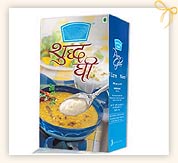 Desi Ghee holds its position of purity in nearly all
the Hindu pooja rituals. In Hindu mythology, Prajapati/Brahma,
created Ghee by rubbing or "churning" his hands together and then
poured it into fire to engender his progeny. So, whenever the Vedic
rituals are performed, the pouring of Ghee into fire symbolises a
re-enactment of creation.
Desi Ghee holds its position of purity in nearly all
the Hindu pooja rituals. In Hindu mythology, Prajapati/Brahma,
created Ghee by rubbing or "churning" his hands together and then
poured it into fire to engender his progeny. So, whenever the Vedic
rituals are performed, the pouring of Ghee into fire symbolises a
re-enactment of creation.According to the Vedas, Ghee is the purest substance obtained from the purest Hindu animal - the cow. Dating as far back as 1500 BC the Rig Veda comprised of hymns that were sung in praise of Ghee. Desi Ghee is used in Hindu temples to light diyas (Lamps) and to prepare the sacred food, or Prasad. This exalted status of ghee makes it not only a sacred and pure, but also a very expensive food, enjoyed only by the rich in the past. The age old study of Ayurveda considers it "the golden oil" of life, some believe that it puts us at a high level of health risk. Desi Ghee Preparation Desi ghee is made by slowly melting butter or cream that has been collected over a period of days. When the butter is heated (110-120°C), there is a lot of frothing, which consists mainly of proteins (casein), impurities and the sediment of non-fat milk solids. When practically all the water evaporates the milk solids in the butter sink to the bottom, and the clear liquid on top is poured off and used in cooking. Because the milk solids are removed from the clarified butter, it can be used at higher cooking temperatures than unclarified butter, and it will also keep longer. Also called drawn butter or anhydrous butter fat, desi ghee does not rancid as readily as butter and can be stored unrefrigerated for several months. Camphor (Kapur/Kapoor)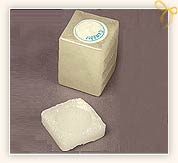 Botanical Name: Cinnamonum camphora
Botanical Name: Cinnamonum camphoraFamily: Lauraceae, The Laurel Family Camphor is a white transparent waxy crystalline solid with a strong penetrating pungent aromatic odor. It is a terpenoid with the chemical formula C10H16O. It is found in wood of the camphor laurel (Cinnamonum camphora), a large evergreen tree found in Asia (particularly in Borneo); it can also be synthetically produced from oil of turpentine. It is used for its scent, as an embalming fluid and for medicinal purposes. It has calming properties. Puja kapoor has a unique place in the Hindu ritual of traditional Pooja or any other festive or customary occasion. The camphor that is burnt has a special quality and naturally has a special meaning. It is pure white in colour, and when it is burnt it takes on the hue of agni (fire), and it burns itself out completely, without residue. Lighting camphor before God symbolises that if we burn our illusion or ego with the fire of true knowledge, we shall merge with the God, leaving no residue. Medicinal Benefits Camphor has excellent medicinal properties. It protects against many diseases in the hot climate that pervades most of India. According to Homeopathy, the camphor and other aromatic substances purify the atmosphere and when the devotees place their palms over the Aarti and bring the palms to their eyes and nose, they absorb the medicinal benefits. The kapoor aarti, lasts for a very short while and thus it signifies the short span of human life and the physical, sensual pleasures, which come of attachments caused by Avidya or Agynana. Thus, Aarti inspires the devotee to seek God who is permanent. Since the Aarti is short lasting, it compels the devotee to focus his attention on the God. Havan Samagri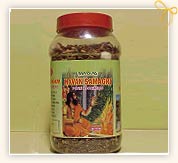 The Havan Samagri is very sacred and each item is
significant. Puja Samagri normally consists of a mixture of sandalwood
powder, lobaan and ghee. Other essential ingredients are :
The Havan Samagri is very sacred and each item is
significant. Puja Samagri normally consists of a mixture of sandalwood
powder, lobaan and ghee. Other essential ingredients are :
The process of eradicating inner imperfections prevalent in our
being is called havan. This process has all the healing techniques
incorporated in it beautifully. It is a rare combination of
accupressure, touch healing, meditation, psychiatry, knowledge and
wisdom.
Havans are age-old sacred rituals to invoke and propitiate various
deities using the sacred fire as a medium for the attainment of
various wishes and boons in the materialistic and the spiritual world
as well.
Havan is a scientific procedure, which is associated with the science of mind and soul. This science was realised by our great rishi-munis or seer scientists in Vedic times, through their mind power. Honey (Madhu) Honey is a sweet and viscous fluid produced by
honeybees from the nectar of flowers. Honey is an integral part of
traditional pooja thali. Honey symbolizes the sweetness of eternal
love, purity and prosperity. During the pooja ritual, honey along with
milk, tulsi and yogurt is poured on the idols. Honey is used to
prepare Madhu-parka - a beverage made of honey, sugar, and milk
is offered to the deity.
Honey is a sweet and viscous fluid produced by
honeybees from the nectar of flowers. Honey is an integral part of
traditional pooja thali. Honey symbolizes the sweetness of eternal
love, purity and prosperity. During the pooja ritual, honey along with
milk, tulsi and yogurt is poured on the idols. Honey is used to
prepare Madhu-parka - a beverage made of honey, sugar, and milk
is offered to the deity.The Sanskrit word for honey is "madhu." In Hindu mythology, the gods Vishnu, Krishna and Indra were called Madhava (the nectar-born ones) and their symbol is the bee. Kama, the Indian god of love, carries a bow strung with bees indicating that love's sweetness can also cause pain. Medicinal Benefits Honey is, in fact, almost pure sugar. About 40 percent by volume is fructose, a simple sugar, which turns into glucose without any digestive change whatsoever and makes honey the quickest source of energy. An additional 34 percent is dextrose, 2 percent is glucose and 18 percent is water. Indian Honey also contains significant amounts of minerals like B-complex vitamins, amino acids and digestive enzymes, but quantities fluctuate according to the composition of the plant from which the bees gathered their nectar. One of honey's most remarkable qualities is its hygroscopic nature. This means that it absorbs moisture from the air or from any moisture-bearing material. The most obvious result is that breads and cakes made with honey stay moist and chewy longer than confections made with sugar. Honey is antiseptic because it destroys the water content in bacteria. For centuries, honey was used to treat wounds and burns, and it is still sometimes employed as a surgical dressing. Because honey helps the skin retain moisture, it is an excellent lotion and facial mask. Painting oneself from head to toe with honey is an effective if messy way to combat dry skin. Lamps/Diyas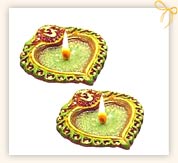 Lamps are an integral part of Hindu pooja thali. The
earthen lamp or 'diya' is the most common, easily available and seen
lamp. Made on the potter's wheel from clay, thousands of these are
turned out every year for use by people. A good diya has to be soaked
in water before use. The single diya is the most common lamp. However,
the potter often lets his imagination run riot to churn out different
types of diyas. Some are just attractive domes with openings to hold
the lamp so that only the slight flickering can be seen while the dome
protects it from wind. Some are a bunch of five diyas - one in the
middle, surrounded by four others.
Lamps are an integral part of Hindu pooja thali. The
earthen lamp or 'diya' is the most common, easily available and seen
lamp. Made on the potter's wheel from clay, thousands of these are
turned out every year for use by people. A good diya has to be soaked
in water before use. The single diya is the most common lamp. However,
the potter often lets his imagination run riot to churn out different
types of diyas. Some are just attractive domes with openings to hold
the lamp so that only the slight flickering can be seen while the dome
protects it from wind. Some are a bunch of five diyas - one in the
middle, surrounded by four others.Why do we light a lamp or diya? Light symbolizes knowledge, and darkness symbolizes ignorance. The Lord is the "Knowledge Principle" (Chaitanya) who is the source, the Enlivener and the Illuminator of all knowledge. Hence, light is worshiped as the Lord himself. Knowledge removes ignorance just as light removes darkness. Also knowledge is a lasting inner wealth by which all outer achievements can be accomplished. Thus, we light the lamp to bow down to knowledge as the greatest of all forms of wealth. Types of Lamps or Diyas There are different types of lamps used for different purposes. The lamp is considered a woman and is symbolic of Goddess Lakshmi (goddess of wealth) and is referred to as Deepalakshmi. Porcelain lamps shaped like diyas are also made these days, as are the ones in terracotta and clay. Designer diyas hold a place of their own. They come in all sizes. The diya is held atop an elephant or a bankura (horse); there are hanging lamps in the shape of pigeons or birds wherein the chain is hooked onto the bird's beak and the body of the bird houses the place for filling oil or wax. An Aarti diya, used at the time of prayer, is different from the one used to light the sanctum sanctorum. The Aarti diya usually has a handle attached to it for holding it. The arrangement of the lamps is also artistic and varies according to place and occasion. These are either placed in circles or in rows. Lamps, thus, play an important role in everyday life in India. Lighting a lamp near a Tulsi plant is a ritual followed by people almost all over the country. Diwali, essentially a Festival of Lights, is all about lamps lighting up life and chasing away darkness. Lighting a lamp in a house is believed to bring prosperity, plenty and abundance to the family. Electricity has not been able to replace the traditional and emotional significance of a humble lamp in the lives of the people of India. Panchagavya In Sanskrit, Panchagavya means the blend of
five products obtained from cow. Panchagavya is made from five
products of the cow -- its dung, urine, milk, ghee and curd. Since
ages Panchagavya is being used by Hindus in traditional
rituals. The uses and healing properties of different components of
Panchagavya are :
In Sanskrit, Panchagavya means the blend of
five products obtained from cow. Panchagavya is made from five
products of the cow -- its dung, urine, milk, ghee and curd. Since
ages Panchagavya is being used by Hindus in traditional
rituals. The uses and healing properties of different components of
Panchagavya are :
Panchagavya is also a traditional method, used to safeguard plants and soil micro-organisms and to increase plant production. Panchagavya application is found to be more profitable than recommended fertilizer application and chemical spray. The modified versions of panchakavya (unique liquid organic fertilizer) used for organic farming have been standarised by experimental trials. 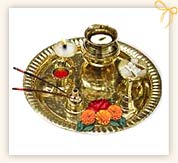 Akshat/Rice grains (Chawal)
Akshat/Rice grains (Chawal)Akshat means unbroken rice grains, which are offered to gain wealth and prosperity and it is offered to the deities by chanting this mantra : "Akshtaashcha Surshreshtth Kumkumaaktaah Sushobhitaah. Mayaa Niveditaa Bhaktyaa Grihaann Parameshwar." The unbroken rice grains also symbolize steadfastness and firmness of the brain and are also a symbol of peace. The rice grain without the husk, called Akshat, is a kind of grain that does not germinate. One cannot grow rice plants by seeding this type of rice. Symbolically it means that rice is the last birth. By offering this in Pooja one should strive to live life in such a way that at the end of this life one will be liberated and not born again. Hand Spun Flower Garland These are beautiful hand-spun hand-woven garlands made of natural flower and fibers like cotton, wool, etc. are an integral part of the decoration of the Idols of any God or Goddess that is routinely followed while doing pooja. Panchpatra & Pali (Charanamrit Set) Panchpatra and pali set (also called Charanamrit set) is made of solid brass and is an integral part of poojas where the holy charan amrit is placed before the deity at the beginning of the pooja and then distributed upon its completion. The Charanamrit literally means Amrit (Holy Nectar) from the Charan (Feet of the Lord) of the deity being worshipped and is partaken as a sacred offering or a holy gift after the completion of the Pooja. Niranjan This is an integral part of any festive ritual or a Pooja. You can perform the daily Aarti or Pooja with this decorative wick-lamp holder in which you can light five wicks placed in oil or ghee. Having multiple wicks instead of a single wick enables the image of God being worshipped to be illuminated completely. Cotton Cotton is used to make cotton wicks while lighting the lamp (Nandadeep, Niranjan or any other) and is thus, the most integral part of the daily or any other festive Pooja. Another usage of this packet of cotton is as a symbolic form of clothing. When the ritualistic "Abhishek" or 'Snana' of the deity is performed, a packet of cotton is offered as a symbol of clothing. Sacred Red Thread : Mouli or Kalawa is a cotton red thread roll, considered to be very sacred and used in all religious purposes of the Hindus. The thread is used as an offering of cloth to the deity. The Mouli thread is an integral part of any puja. Normally the Mouli is tied around the Sadhana article, that is, Mouli is tied around a copper tumbler filled with water. On its mouth five mango leaves are placed with a coconut in a red cloth over them. This represents the shrine you are offering pooja and is known as "Kalash Sthapana". Next, before the start of the pooja, the red sacred thread is tied around the wrist of the members of the family. As a rule, all males and married females wear it on the right hand. Unmarried females wear it on their left hands. Only the Brahmin females, both married and unmarried can wear it in their right hands. The basic significance of wearing this thread is to get blessings from God. Abir This is also in important part of the Pooja custom and is used for decorative purpose and is applied as a 'tilak' on the forehead of the Deity. Haldi (Turmeric) This is used as a decorative item and is primarily used for applying 'tilak' on the forehead of the deity. Haldi is a very cleansing substance and represents the purifying of the thoughts to adorn the mind. Janeu/Janou It is considered to be the most important part of Hindu culture to wear the sacred and auspicious white thread called Janeu/Janou. It is mandatory and most important to wear the sacred Janeu/Janou while doing any Pooja or any act of devotion or worship. A special ceremony called the Upanayan Sanskar is held wherein an unmarried boy is granted the Janeu and from then on can participate in every Vedic ritual. If for some reason, this ceremony is not done during the childhood, it is mandatory to be held before marriage. A Hindu male cannot get married unless he has worn the Janeu. Dry Fruits Various kind of dry fruits are used as offerings in pooja thali, which include almonds, cashews, walnuts, kismis & pista.
Vermillion/Sindoor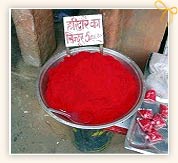 Vermilion/Sindoor is worn in the center parting of
the hair by married Hindu women. Sindoor is made of sulfides of
mercury or by cinnabar. Sindoor is applied to Hindu goddesses like
Parvati, Lakshmi, Durga, etc. Sindoor stands for power and good
fortune and is a sign of "Soubhagya" in the case of a married
Hindu women.
Vermilion/Sindoor is worn in the center parting of
the hair by married Hindu women. Sindoor is made of sulfides of
mercury or by cinnabar. Sindoor is applied to Hindu goddesses like
Parvati, Lakshmi, Durga, etc. Sindoor stands for power and good
fortune and is a sign of "Soubhagya" in the case of a married
Hindu women.Historical Aspect of Vermilion/Sindoor The tradition of wearing sindoor or vermilion by Indian women dates back to 5,000 years. Excavations of female figurines from Mehrgarh, Baluchistan, have proved that vermilion was worn by women even in Harrappan times. The use of sindoor has also been mentioned in the Puranas, Lalitha Sahasranamam and Soundarya Laharis. In the famous epic Mahabharata, Draupadi, the wife of the Pandavas, is believed to have wiped her sindoor in disgust and despair at the happenings in Hastinapur. Practices Associated with Vermilion/Sindoor During the marriage ceremony, Sindoor is applied for the first time to a Hindu woman by her bridegroom and is called the "Sindoor Dana" ceremony. Even in the ancient Aryan society, a bridegroom made a 'tilak' mark on the bride's forehead as a sign of wedlock. The present practice could be an extension of that tradition. In traditional Hindu society, wearing sindoor is considered must for married Hindu women. It is a visible expression of their desire for their husbands' longevity. Traditionally therefore, widows did not wear vermilion. Mythological Explanations The tradition of wearing vermilion/sindoor by married women has been explained with the help of mythology. According to the scholars, red is the color of power and vermilion represents the female energy of Sati and Parvati. Sati is considered an ideal Hindu wife because she gave her life for her husband's honor. Hindus believe that Goddess Parvati grants "Akhand Soubhagya" (lifelong good fortune) to all the females who wear sindoor in their hair parting. Physiological Aspect of Vermilion/Sindoor Vermilion/sindoor is prepared by mixing turmeric-lime and mercury. Mercury controls blood pressure and activates sexual drive. Sindoor should be applied right up to the pituitary gland where all our feelings are centered. Thus, this also proves why sindoor is prohibited to widows. Sandalwood (Chandan)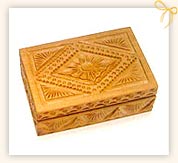 Sandalwood is an Indian plant that has an
extraordinary fragrance. Sacred rituals are accompanied by offerings
composed of the five elements: Earth is represented with sandalwood
paste. The paste is smeared on the foreheads of devotees of Vishnu and
Shiva as a tilak or dot. The sandalwood dot is meant to cool and
protect the "Agna chakra" present between the eyebrows. The
fragrance of sandalwood is also said to be an aphrodisiac.
Sandalwood is an Indian plant that has an
extraordinary fragrance. Sacred rituals are accompanied by offerings
composed of the five elements: Earth is represented with sandalwood
paste. The paste is smeared on the foreheads of devotees of Vishnu and
Shiva as a tilak or dot. The sandalwood dot is meant to cool and
protect the "Agna chakra" present between the eyebrows. The
fragrance of sandalwood is also said to be an aphrodisiac.Sandalwood is commonly used for incense, religious ceremonies, aromatherapy, fragrance industry and fine woodworking. Sandalwood is a not an ideal building material. However, a few temples in India have been constructed by sandalwood and have retained the smell of chandan after centuries. It is also used for making jewelry boxes, fans and ornate carvings. In India, for centuries, the death pyre is made using sandalwood branches. In Sri Lanka, since 9th century, the sandalwood paste was used to embalm the corpses of royal family. Sandalwood, alongwith agarwood, is the most popular and commonly used incense material by the Chinese and Japanese in worship and various ceremonies. Myths and Legends Legend say that Lord Ganesha was created by Goddess Parvati - wife of Lord Shiva. Goddess Parvati created Ganesha out of sandalwood paste that she used for her bath and breathed life into the figure. In Indian mythology, sandalwood tree is depicted as being entwined with serpents. Sandalwood remains aromatic and cool even when the poisonous serpent coils around it. This portrays that the basic nature of an individual cannot change because of outer effects. Botanical Description of Sandalwood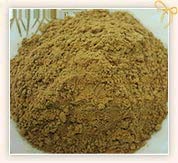 Botanical Name : Santalum album
Linn.
Botanical Name : Santalum album
Linn.Family : Santalaceae, The Sandalwood Family Extents The sandalwood tree is found in southern parts of India, Sri Lanka, Hawaii and a number of South Pacific Islands. Tree Description Sandalwood is a partial parasite that uses nutrients derived from hosts to grow. Nearly 300 species of hosts have been found including grasses, herbs, shrubs and trees. Sandalwood is a small evergreen tree about 20 to 30 feet high with many opposite slender drooping branches and a smooth gray-brown bark. Leaves are smooth and ovate in shape. The light yellow colored wood is heavy and hard but splits easily. The cross section of the wood shows alternating light and dark concentric zones which give a fair idea of the age of the tree. Sandalwood has a persistent odor and a peculiar taste. Sandalwood Flowers are small, numerous with short stalks. The flowers are found at the top of the plant. Sandalwood flowers twice very year from March to April and then from September to October. Sandalwood Fruits are spherical, concealed and the size of a pea. The fruit is crowned by rim-like structure. It is smooth, fleshy and nearly black with single seed. Cultivation and Production of Sandalwood/Chandan Sandalwood is harvested by uprooting the entire tree. This way, the valuable wood from the stump and root can also be sold or processed for oil. The branches are worthless. The trunk is left on the ground for a few months so that white ants could eat away the worthless outer wood - sap wood. The stump is then trimmed and sent to saw mills. There it is trimmed again and graded(according to quality). Indian sandalwood is an endangered species so its cultivation and production is under government control. Commercially valuable sandalwood has high levels of fragrance oils and is harvested at the age of 40. However, 80 years or an age above this is preferred. Inferior sandalwood produced from trees of 30 years can also fetch a decent price due to high demand for real sandalwood. Uses of Sandalwood
Sandalwood is has many uses
like :
Fragrance
Religious Use
Medicines
Cosmetics
Crafts Miscellaneous Powders/Pastes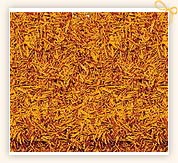 Ashtagandha
AshtagandhaAshtagandha is a mixture of eight fragrant herbs. Vedic talismans are written on Bhojapatra or Onion skin with a special ink. This ink is made of Ashtagandha herbs, 24 karat gold dust and Ganges water. It is said that the fragrance of Ashtagandha used to continuously emanate from the form of Lord Krishna. Shrigandha Shrigandha is the fragrant paste of sandalwood. It is used to smear Hindu Gods as part of their bathing ritual. Turmeric (Haldi Powder) According to Vedic literature, turmeric usage in
India dates back to nearly 4000 years when it was the principal spice
and also of religious significance. Turmeric is a very important spice
in India. India is also the biggest producer and uses about 80% of
that produce. It is employed in some Hindu rituals, where the yellow
color symbolizes the Sun or Maitreya.
According to Vedic literature, turmeric usage in
India dates back to nearly 4000 years when it was the principal spice
and also of religious significance. Turmeric is a very important spice
in India. India is also the biggest producer and uses about 80% of
that produce. It is employed in some Hindu rituals, where the yellow
color symbolizes the Sun or Maitreya.Turmeric or Haldi is one of the most commonly used spice in South Asian cuisine. It has a peculiar fragrant odor, a bitter taste(like ginger) and colors the saliva yellow. It is used as a holy paste in religious rituals, to add color to curries, as an antiseptic and as an anti-coagulant. It makes a poor dye since it is not colorfast. Another variety, known by as "white turmeric", is consumed by Southeast Asians and is available from late spring to summer. The rhizomes of white turmeric are lighter in color and have a pungent taste. This turmeric is cooked, the young roots are also eaten raw or blanched, dipped in spicy sauces. Ordinary Turmeric cannot be eaten as a vegetable because of its staining properties. In Ayurveda, turmeric is said to have many medicinal properties. In some Asian countries, it is taken as a dietary supplement to treat stomach and digestive problems. In Okinawa, Japan, turmeric is popular as tea. Botanical Description of Turmeric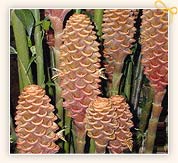 Botanical Name : Curcuma longa Linn
Botanical Name : Curcuma longa LinnFamily : Zingiberaceae, The Ginger Family Extents Turmeric/Haldi is extensively cultivated in South East Asia. In India, the main trading center for Turmeric is Sangli in Maharashtra. Sangli is also the most important turmeric trading center in the entire world. Turmeric Plant Turmeric plant is a perennial plant which grows to a height of about 3 to 5 feet and has deep orange roots or tubers. The leaves are long, smooth uniform green and tapering at each end. Rhizomes or root tubers are powdered to obtain turmeric powder. Turmeric Plant is a perennial plant which grows to a height of about 3 to 5 feet and has deep orange roots or tubers. The leaves are long, smooth uniform green and tapering at each end. Rhizomes or root tubers are powdered to obtain turmeric powder. Propagation of Turmeric plant is done through root cuttings. The cuttings have parallel rings with a yellow shade on the outside and reddish brown on the inside. Composition of Turmeric The turmeric plant contains a yellowish coloring matter called Curcumin, an acrid volatile oil, starch, chlorides of calcium, woody fiber and gum. The acrid oil is called turmerol and has an aromatic odor. Alkaloids of oxalic acid are also present that yield crystals of potassium oxalate. Medical Research on Turmeric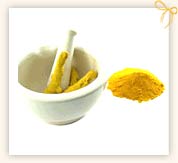 For centuries, the ancient Indian texts have stated
the almost magical qualities of turmeric. However, it is only in
recent years, that the Western world has woken up to this ancient
knowledge of the medicinal uses of turmeric. Research activity into
Curcumin - the active ingredient of turmeric, has increased.
For centuries, the ancient Indian texts have stated
the almost magical qualities of turmeric. However, it is only in
recent years, that the Western world has woken up to this ancient
knowledge of the medicinal uses of turmeric. Research activity into
Curcumin - the active ingredient of turmeric, has increased.The following researches/studies have been undertaken to study the effects of turmeric and curcumin on the various diseases :
Uses of Turmeric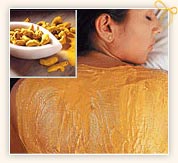 Since ancient times, turmeric has been used as a
traditional medicine and for beauty care. In Ayurvedic system of
Indian medicine, turmeric is an important herbal medicine prescribed
for various diseases. In fact, turmeric is even used in modern times
to plug radiator leaks in water-cooled radiators.
Since ancient times, turmeric has been used as a
traditional medicine and for beauty care. In Ayurvedic system of
Indian medicine, turmeric is an important herbal medicine prescribed
for various diseases. In fact, turmeric is even used in modern times
to plug radiator leaks in water-cooled radiators.The various uses of turmeric are as follows : Food Additive
Medicinal
Cosmetics
As a tester for Acids and Alkalies
Miscellaneous Uses
Mehndi/Henna Mehndi/Henna is used as a temporary dye to
artistically decorate hands and legs usually during a marriage
ceremony or during festivals. In India, Mehndi is said to be
auspicious and considered a symbol of "Soubhagya" (good
fortune). Therefore, it is not applied to widows. Mehndi and Henna are
interchangeable names because they are applied to both the plant from
which leaves are obtained and also to the body art.
Mehndi/Henna is used as a temporary dye to
artistically decorate hands and legs usually during a marriage
ceremony or during festivals. In India, Mehndi is said to be
auspicious and considered a symbol of "Soubhagya" (good
fortune). Therefore, it is not applied to widows. Mehndi and Henna are
interchangeable names because they are applied to both the plant from
which leaves are obtained and also to the body art.Mehndi is used for coloring hair and for temporary body art. It does not cause allergies. Mehndi when used coats only the dead cells of the upper layer of skin. The depth of penetration depends on the duration for which the paste was left on the body. The satin lasts longer if it is fully absorbed by the skin. Another variety of Mehndi called Black Henna is also common in Middle East. It is an artificial product created by the addition of Paraphenylenediamine (PPD) to natural henna to create a black stain. This henna causes a lot of skin allergies and requires medical treatment. Origins Some historians and researchers believe that Mehndi originated in India. While others believe that it was brought to India by travelers from Middle East and North Africa. The illustrated Bodhisattivas and deities on the cave walls of Ajanta prove that Henna was part of the Indian culture in the 4th and 5th centuries. Designs of Mehndi/Henna Henna has been associated with special celebrations like engagements, weddings, the eighth month of pregnancy, the birth, the 40th day after a woman gives birth, naming ceremonies, festivals, etc. Various designs are applied and they symbolize good health, fertility, wisdom, protection and spiritual enlightenment. The Indian Mehndi styles involve fine, thin lines for floral and paisley patterns covering hands, forearms, shins and feet. The Arabic styles are quite in fashion now and are usually large and floral. Botanical Description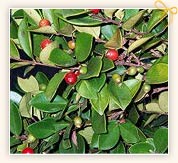 Botanical Name : Lawsonia inermis, Synonym
Lawsonia alba
Botanical Name : Lawsonia inermis, Synonym
Lawsonia albaFamily : Lythraceae, The Pomegranate Family Extents Mehndi is grown in India, Sudan, Egypt, Middle east countries and countries of North Africa. This plant thrives well in hot and humid climate. Plant Description Mehndi is medium sized shrub that sometimes takes a tree like shape and growth. It has many angled branches with opposite sharp pointed leaves. Mehndi Flowers are small, white or pink in color, fragrant and grow in large bunches at the top of the shrub. Mehndi Fruit is pea sized, small and round. It has many seeds. Cultivation of Mehndi The propagation of Mehndi is done through stem cuttings. Cuttings of henna are planted in June when the monsoons are about to arrive. The plant requires good water and fertilizer supply to grow. It can withstand high temperatures. Leaves are plucked thrice a year - May-June, August-September and December-January. The quality of leaves is very high initially and deteriorates with every picking. Processing of Mehndi Premium quality mehndi leaves are selected, cleaned and dried in shade. If the leaves are very dry, the powder obtained would be fine and will give a stronger shade of mehndi. Impurities like roots, sand, dust, weeds etc. make the quality of the powder inferior. Quality is also affected if the leaves are powdered before they are completely dry. Henna Uses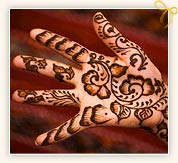 Mehndi/Henna is mainly used for adorning hands and
feet during weddings and festivals. It is considered auspicious and so
is used on every happy occasion and festival.
Mehndi/Henna is mainly used for adorning hands and
feet during weddings and festivals. It is considered auspicious and so
is used on every happy occasion and festival.Coloring Agent and Fragrance
Medicinal
|
||||||||||||||